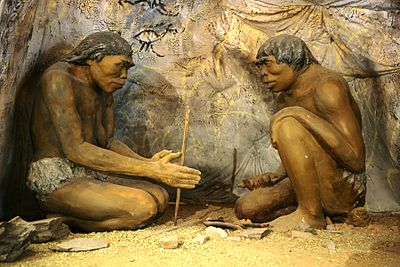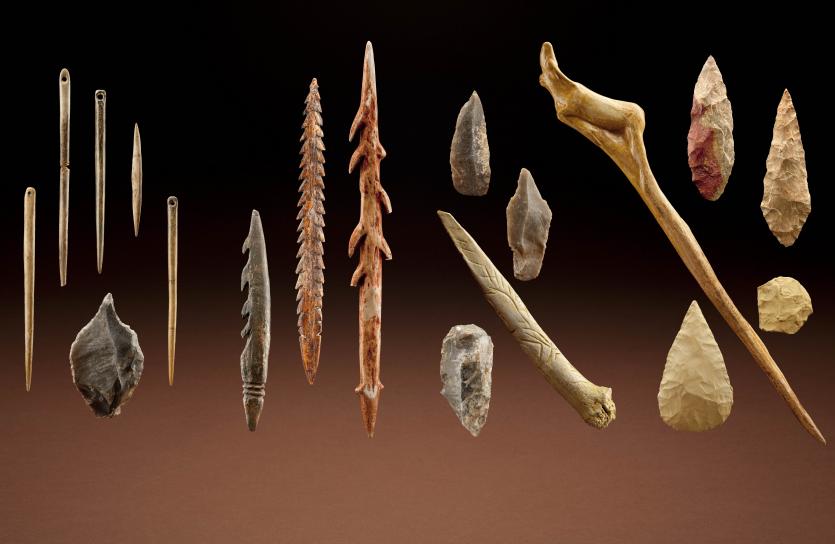Cultural Evolution
At Darwin’s time, nothing was known about genes. Darwin and others only knew from observations in the world that there is a lot of variation between and within speices, and that offspring resembled their parents. Characteristics are inherited in some way to offspring, and new variation come into the world somehow. So Darwin formulated his theory of evolution by natural selection very general and without reference to a specific inheritance mechanism or a specific thing that carried the information about traits. Through the work of Gregor Mendel and with the discovery of the DNA, biologists were sure that they had now found the structure that encoded the information about traits and the mechanism that allows the inheritance of traits (reproduction and inheritance of DNA to offsrping). Thus, the theory of evolution was rewritten in the 1940s as “a change in allele frequencies in populations.” This formulation of evolutionary theory is called “Modern Synthesis”.
But in recent decades, many biologists have noticed that inheritance of genes can not alone explain all the traits that we observe in living things. For example, many animals appear to “inherit” behaviors to offspring and others by imitation. Also, many animals seem to “inherit” or pass on structures created by them to their offspring, which have an influence on their chances of survival and reproduction.
Especially in the field of human evolution, it seems that we must consider these other modes of inheritance: humans have many cultural traits and technologies that have no genetic basis (or: the variation in cultural traits we see in the world does not correspond to a variation in genotypes), and yet these traits vary and are transmitted to others in a population, even selectively (some traits are transmitted more than others).
So, many biologists suggested that we need to expand the definition of evolutionary theory to explain the variation, selection and transmission of phenotypic traits and things that are not very tightly linked to genes and to generation change. Cultural evolution, i.e. the changes and distributions of behaviors, beliefs, norms, knowledge, technologies, worldviews, institutions, and other cultural traits in populations, can be studied and explained with the help of this generalized or extended theory of evolution.
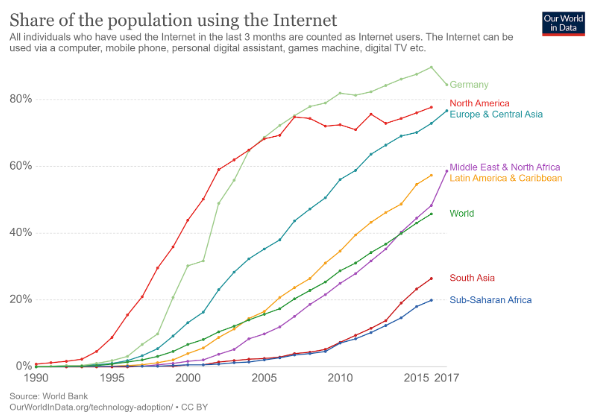
Cultural evolution (lesson plan)
Students explore the concept of cultural evolution by comparing it to genetic evolution based on a number of concepts, and explore why cultural evolution is so important in our species.
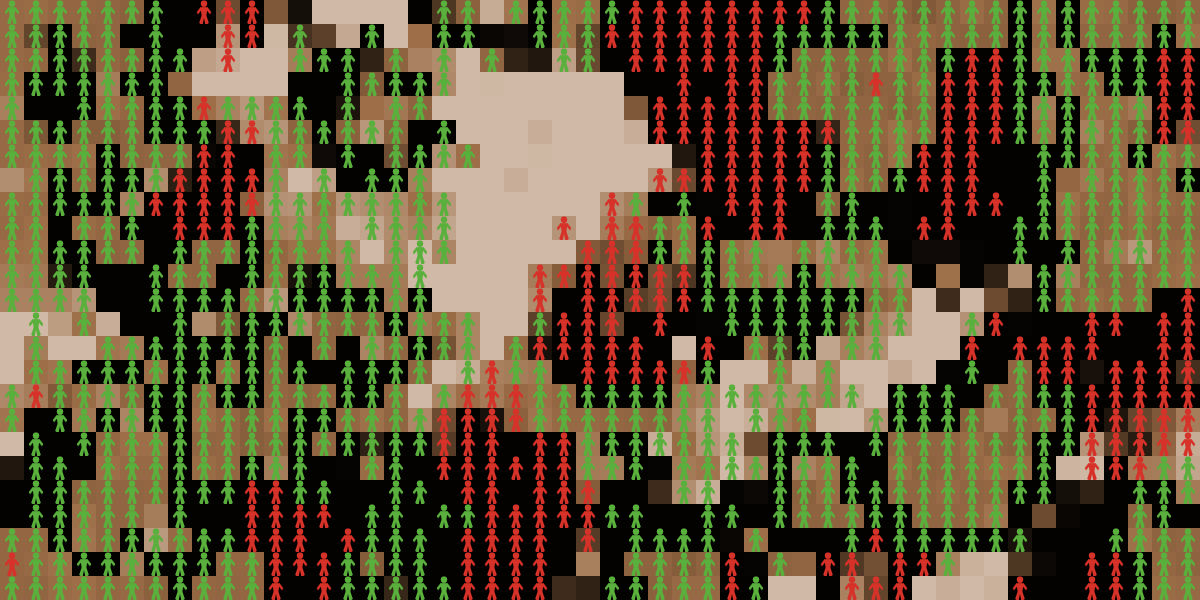
NetLogo: Evolution of resource use through behavior imitation
This model adds cultural evolutionary dynamics through behavior imitation to the evolution of resource use behavior.
Comparing gene-focused approaches and phenotype-focused approaches to evolution
Genotype-focused
Phenotype-focused
What changes in the population are focused on?
What are the causes of new variation in traits?
How does the “selection” of traits occur?
Through what other mechanisms can traits spread or disappear in a population?
How is the trait inherited or transmitted within the population?
Different possible mechanisms depending on the trait: inheritance of genes (genetic inheritance) and gene-regulatory networks (epigenetic inheritance); social learning, teaching (behavioral, symbolic inheritance); accumulation of created things and structures that persist in the environment over time (ecological inheritance)
What is the meaning of the term “fitness”?
Number of surviving offspring; the increasing frequency of the gene/allele in the population
Depending on the trait: number of surviving offspring; number of imitators; stability or persistence of a trait, the increasing frequency of the trait or thing in the population
Can living beings adapt to environmental conditions in the course of a lifetime?
No, because the genome in the germ cells of an organism does not change in the course of a lifetime. Only populations can adapt.
Yes, because many organisms can change their behavior or their environment, or create new things.
Some biologists consider organisms themselves as populations of cells and trait variants, which “evolve” over their lifetime through different mechanisms of variation and selective retention.
Where is information stored?
In genomes and gene pools
In genomes, gene pools, gene-regulatory networks, brains/neural networks, social networks, and the environment (structures, technologies, books, internet…).
Why is cultural evolution so important in our species, compared to other species?
While there is debate among scientists about the degree to which human culture – and our capacitities for culture – are similar or different to the culture of other animals, hardly anyone can disagree that the role of culture in our species is unique. For example, in no other animal species is there such a degree of cultural diversity, and no other species has transformed their environment in such drastic ways with the help of culture. From the perspective of evolutionary biology and anthropology, this phenomenon needs to be explained just as the nut cracking of chimpanzees, the nest building of ants, or the peacock’s tail.
The table above indicates that a number of traits are important for cultural evolution to “take off” in a population – particularly the abilities and motivations for imitation and teaching. Furthermore, the larger the group sizes, the higher the chances that cultural traits will be “stored” in brains and social networks rather than getting lost, which enables cumulative culture.
Based on the findings from various research methods, inluding cross-developmental, cross-species and cross-cultural behavioral experiments, computer simulations, and archeological findings, anthropologists conclude that humans seem to have certain tendencies to learn or imitate certain cultural traits or individuals in their social group more than others, so-called imitation biases. These biases are probably the result of natural selection over the course of human evolution in which life depended more and more on living and cooperating in groups. These biases make adaptive cultural traits more likely to spread (though not always – traits can also be maladaptive for groups or individuals or over certain time spans) and lead to groups becoming more homogenous within but different from each other.
Some important imitation biases include:
- the tendency to imitate the majority and regard the behaviors of the majority as “normal” (frequency-dependend bias, conformity bias, norm-psychology)
- the tendency to imitate the most successful or prestigious individuals (prestige-bias; whatever “success” or “prestige” means)
- the tendency to imitate or adopt the trait based on certain attractive trait properties (e.g.: it makes life easier, it is cheaper, it looks nice, it feels nice, it is easier to learn, etc.)
- Also personal preferences (e.g. what I consider desirable) and the social environment or the group with which we identify (e.g. what is considered desirable in my group) play a role in the degree to which we might learn or adopt certain cultural traits
All these biases and preferences will interact in complex ways and cultural evolution scientists are still debating and investigating the degree to which all these biases are important in influencing the cultural evolution of traits.
Causal map for cultural evolution
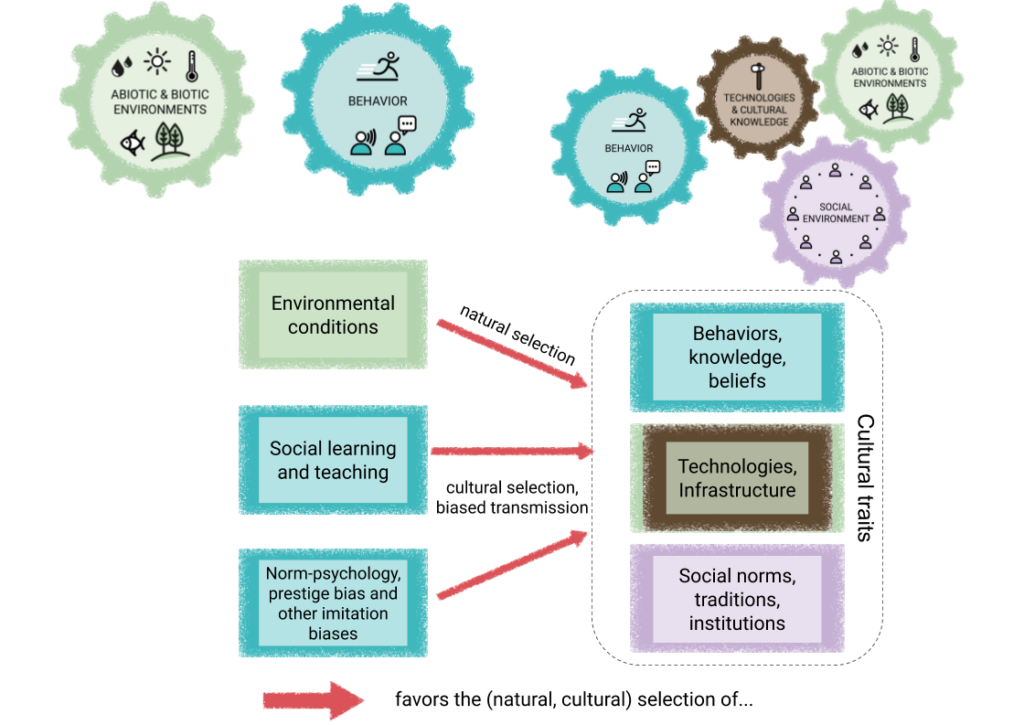
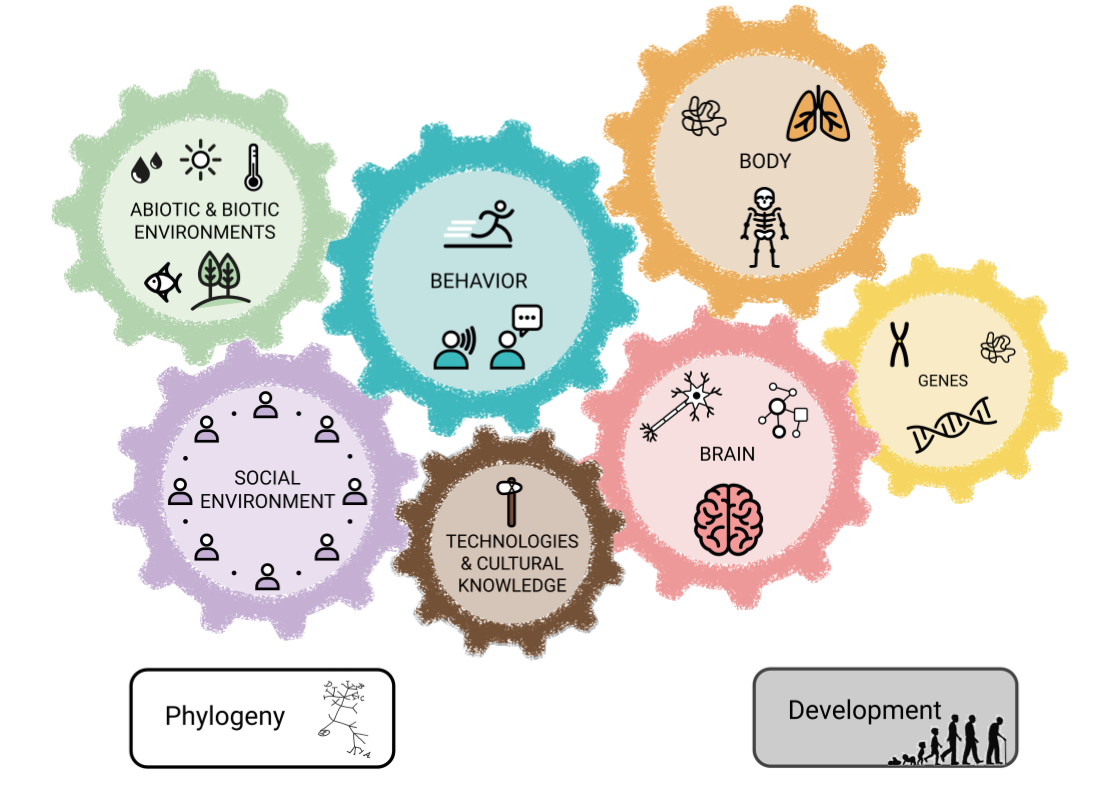
Causal maps on the evolution of human traits
All causal maps on human evolution in one Google slide file
Cultural evolution and sustainability
Our understanding of cultural evolution is relevant to addressing the challenges for sustainable development:
- Why and how do “unsustainable” behaviors and other negative characteristics spread?
- How can we use our understanding of cultural evolution and people’s imitation biases to promote the spread of “sustainable” behaviors and other desired traits?
- What role can greater awareness of our own values and of the influences of our social environment play in influencing which kinds of behaviors we adopt?
Sustainability scientists and behavioral scientists are increasingly dealing with these questions.
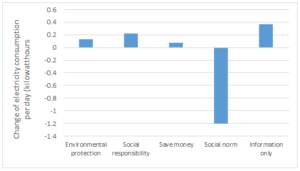
What motivates people to save energy
A set of behavioral experiments to find out what motivates people to save electricity, exploring the roles of monetary incentives, social norms, appeals to the environment or to citizenship.
The beginnings of our cultural evolution (traits: technologies)
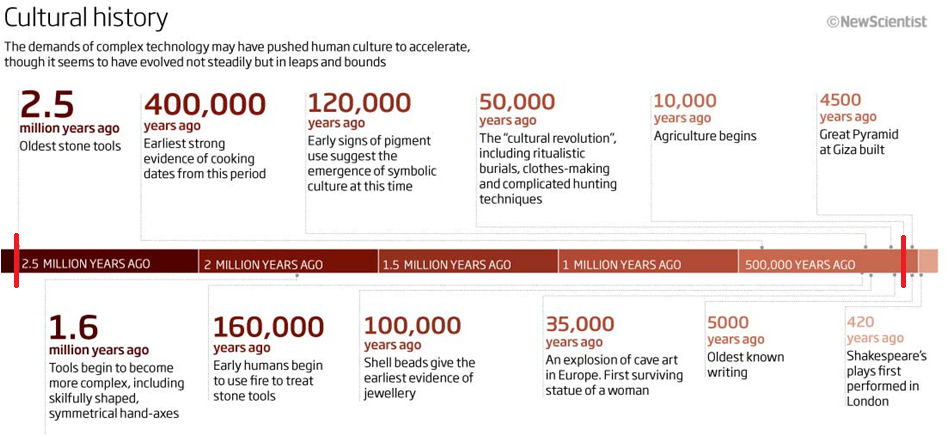

3 – 2.5 Mio years ago: First Oldowan stone tools and the beginning of the stone age.
The making of these tools may already have required a higher patience, ability to plan a few steps ahead, better control and coordintaion of hand movements, compared to the tool making observed among chimpanzees. (see First stone tools)
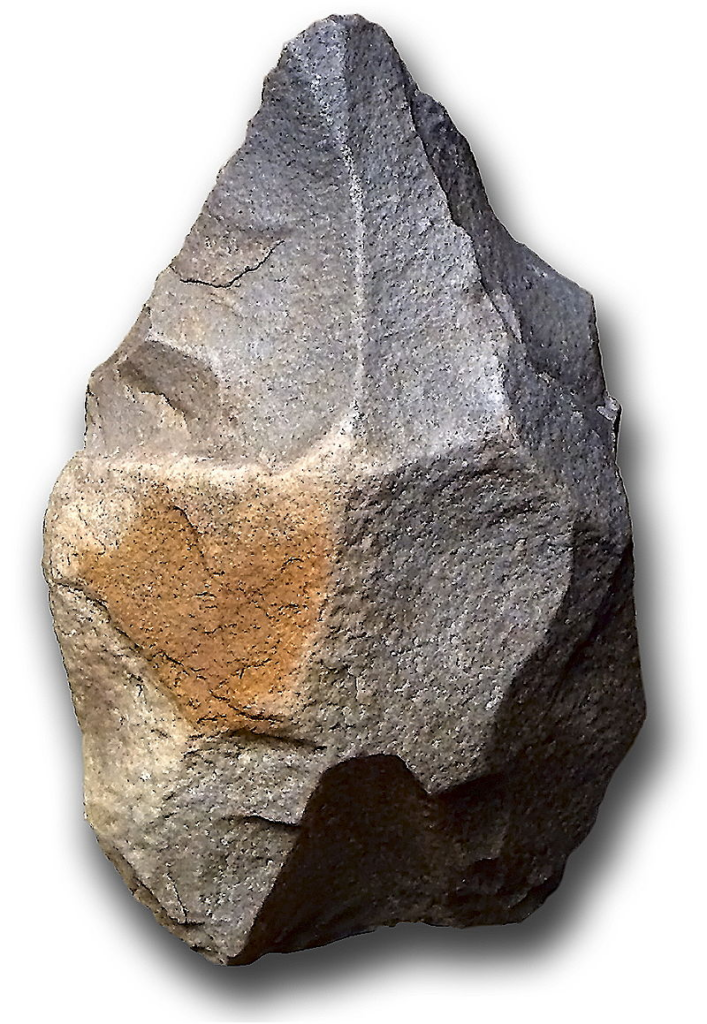
1.7 Mio years ago: The hand axe as the next innovation of stone tools.
The quality and variation of the hand axes increased steadily from this point onwards. The length of time and steps between identifying a problem (“finding food”) and solving it have become longer – tools were increasinlgy manufactured for the future, and transported across more distances, which required increased cognitive abilities. The passing on of this technology also required increased skills for social learning and teaching.
Reflection: Between the appearance of the first Oldowan stone tools and the emergence of the first hand axe, about 1 million years have past! What could be the reasons why there did not seem to be any far-reaching innovations in tool making in the populations of our ancestors over such a long period of time?
About 1 million years ago: First signs of the use of fire. Fire allowed, among others, greater protection against predators, especially at night.
About 800,000 years ago, Homo erectus was apparently able to control fire. Processing meat with the help of fire made it easier to chew and digest, making meat-based energy more efficient, improving the food supply to the group, and further reducing selection pressure on the physical “chewing tools” of the body and on digestive organs.
Use of fire certainly also had an impact on social life – sitting together by the fire, showing each other things, and eventually telling stories of the past and future.
Ca. 400 000 years old spear from Schöningen, Germany.
Starting ca. 300 000 years ago: Tools of the middle stone age.
Tools from many different materials (stone, wood, bone), for many different purposes, including for processing many other materials
References
- Acerbi, A., & Mesoudi, A. (2015). If we are all cultural Darwinians what’s the fuss about? Clarifying recent disagreements in the field of cultural evolution. Biology and Philosophy, 30(4), 481–503. https://doi.org/10.1007/s10539-015-9490-2
- Brooks, J. S., Waring, T. M., Borgerhoff Mulder, M., & Richerson, P. J. (2018). Applying cultural evolution to sustainability challenges: an introduction to the special issue. Sustainability Science, 13(1), 1–8. https://doi.org/10.1007/s11625-017-0516-3
- Chudek, M., & Henrich, J. (2011). Culture-gene coevolution, norm-psychology and the emergence of human prosociality. Trends in Cognitive Sciences, 15(5), 218–226. https://doi.org/10.1016/j.tics.2011.03.003
- Laland, K. N., Uller, T., Feldman, M. W., Sterelny, K., Müller, G. B., Moczek, A. P., … Odling-Smee, J. (2015). The extended evolutionary synthesis: its structure, assumptions and predictions. Proc. R. Soc. B, 282(1813), 20151019. https://doi.org/10.1098/rspb.2015.1019
- Laland, K. N., Uller, T., Feldman, M., Sterelny, K., Müller, G. B., Moczek, A. P., … Strassmann, J. E. (2014). Does Evolutionary Theory Need A Rethink. Nature, 514, 161–164. https://doi.org/10.1038/514161a
- Mesoudi, A., Whiten, A., & Laland, K. N. (2006). Towards a unified science of cultural evolution. Behavioral and Brain Sciences, 29(4), 329–347. https://doi.org/10.1017/S0140525X06009083
- Mesoudi, A. (2007). Biological and Cultural Evolution: Similar but Different. Biological Theory, 2(2), 119–123. https://doi.org/10.1162/biot.2007.2.2.119
- Mesoudi, A. (2011). Cultural Evolution: How Darwinian Theory Can Explain Human Culture and Synthesize the Social Sciences. Chicago, USA: University of Chicago Press.
- Richerson, P. J., & Boyd, R. T. (2005). Not by Genes Alone. How Culture Transformed Human Evolution. Chicago, USA: University of Chicago Press.


